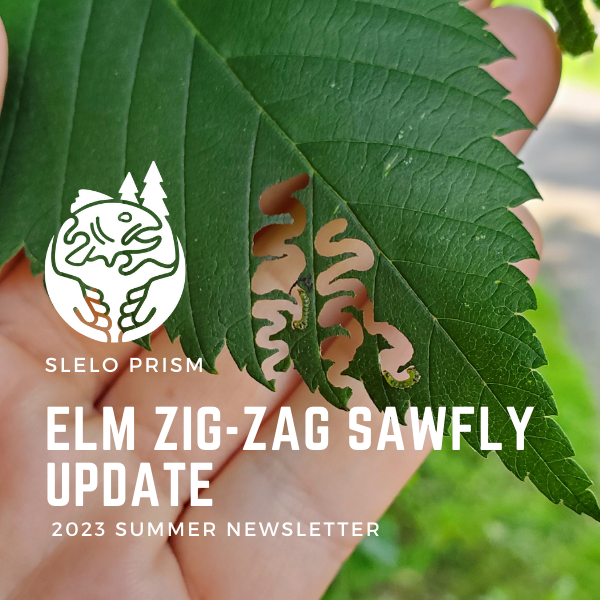This article was featured in the 2023 summer newsletter by Liam Somers, NYS DEC.
Elm zigzag sawfly (EZS) (Aproceros leucopoda), an exotic pest native to east Asia that feeds exclusively on elm species, has been detected in many locations across New York State this season. EZS was first detected in St. Lawrence County in August 2022. Since, it has been found in Allegany, Ontario, Madison, Ulster, Schenectady, Albany, Saratoga, Warren, and Clinton, with new counties being confirmed weekly. Most reported defoliation has been light (2-5%), but a group of Siberian elm in a residential backyard of Niskayuna were severely defoliated (Figure 1). Although EZS are known to be great fliers with the ability to travel up to 56 miles in a year, the rate of new detections indicates that EZS may have been more widespread than initially thought.

Urban forests could endure the worst of EZS damage, as various elm cultivars are widely planted in ornamental landscapes. Open-grown elms with large canopies provide abundant foliage to support multiple generations of EZS within a growing season and are vulnerable to complete defoliation from time to time. Healthy elms, however, may withstand occasional defoliation and treatment may not be necessary.
If treatment is desired, general-purpose insecticides labeled for use on trees and shrubs can be used. Spinosad, an insecticidal product derived from a soil bacterium that affects the nervous system of insects and mites, is highly effective against sawfly larvae.
As a newly introduced species, the impact of EZS on our forests is not yet clear. The DEC has partnered with the SUNY College of Environmental Science and Forestry to conduct research on the phenology, damage severity, and associated insect community of EZS.
This research will help us better understand how EZS interacts with our environment and what, if any, natural controls might be present. The DEC also participates with a working group of practitioners and researchers from all states with EZS present, in order to stay up-to-date on current research and best management practices.
The public can report sightings to iMap Invasives, in order to help us better determine the current distribution of EZS in New York. If you’d like to aid in early detection efforts across the St. Lawrence Eastern Lake Ontario region, SLELO PRISM has developed an invasive species Volunteer Surveillance Network with partners and community members. To join this effort, please visit the SLELO Elm Zigzag Sawfly webpage and fill out the form on the bottom of the page.
Related
Two New Species On The MoveIn "News"
Early Detection Effort for Elm Zigzag Sawfly In "Newsletter"
Species Spotlight: Box Tree Moth and Elm Zigzag Sawfly In "Newsletter"


